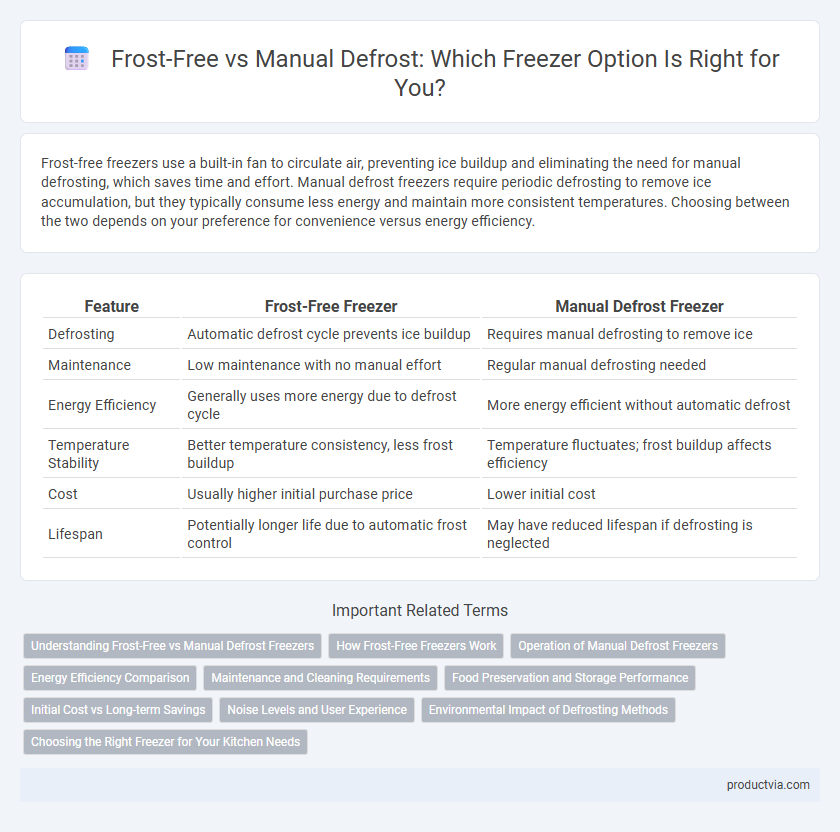Frost-free freezers use a built-in fan to circulate air, preventing ice buildup and eliminating the need for manual defrosting, which saves time and effort. Manual defrost freezers require periodic defrosting to remove ice accumulation, but they typically consume less energy and maintain more consistent temperatures. Choosing between the two depends on your preference for convenience versus energy efficiency.
Table of Comparison
| Feature | Frost-Free Freezer | Manual Defrost Freezer |
|---|---|---|
| Defrosting | Automatic defrost cycle prevents ice buildup | Requires manual defrosting to remove ice |
| Maintenance | Low maintenance with no manual effort | Regular manual defrosting needed |
| Energy Efficiency | Generally uses more energy due to defrost cycle | More energy efficient without automatic defrost |
| Temperature Stability | Better temperature consistency, less frost buildup | Temperature fluctuates; frost buildup affects efficiency |
| Cost | Usually higher initial purchase price | Lower initial cost |
| Lifespan | Potentially longer life due to automatic frost control | May have reduced lifespan if defrosting is neglected |
Understanding Frost-Free vs Manual Defrost Freezers
Frost-free freezers use an automatic defrost system that prevents ice buildup by periodically circulating warm air, ensuring consistent temperatures and reducing maintenance. Manual defrost freezers require users to turn off the appliance and remove ice manually, which can be time-consuming but often provides better temperature stability and uses less energy. Choosing between frost-free and manual defrost freezers depends on balancing convenience, energy efficiency, and temperature control preferences.
How Frost-Free Freezers Work
Frost-free freezers use an automatic defrost system that circulates warm air around the freezer compartments to prevent ice buildup, maintaining consistent temperatures without the need for manual defrosting. A built-in fan helps distribute cold air evenly, while a heating element periodically activates to melt any frost accumulation, which then drains away safely. This technology ensures food stays fresher longer and eliminates the hassle of manually defrosting, unlike manual defrost freezers that require regular melting and cleaning of ice.
Operation of Manual Defrost Freezers
Manual defrost freezers require periodic ice removal by turning off the unit and allowing frost to melt, which enhances energy efficiency by preventing thick ice buildup that can insulate and reduce cooling. These freezers rely on natural thawing cycles, demanding user intervention to maintain optimal performance and storage conditions. Because of manual defrosting, they often consume less electricity compared to frost-free models, making them a cost-effective choice for long-term freezing needs.
Energy Efficiency Comparison
Frost-free freezers use an automatic defrosting system that prevents ice buildup, maintaining consistent temperatures and improving energy efficiency by reducing compressor workload. Manual defrost freezers require periodic defrosting to eliminate ice, which can cause temperature fluctuations and increase energy consumption over time. Energy-efficient models often favor frost-free technology as it reduces ice buildup and maintains optimal cooling performance without frequent power surges.
Maintenance and Cleaning Requirements
Frost-free freezers require minimal maintenance since their automatic defrosting system prevents ice buildup, reducing the need for manual cleaning and ensuring consistent performance. Manual defrost freezers demand regular defrosting sessions to remove ice accumulation, which can be time-consuming but often results in more energy-efficient operation. Proper cleaning is essential for both types to prevent odors and ensure food safety, but the frequency and effort required differ significantly based on the defrosting technology.
Food Preservation and Storage Performance
Frost-free freezers maintain consistent temperatures by automatically preventing ice buildup, which enhances food preservation by reducing freezer burn and maintaining optimal storage conditions. Manual defrost freezers often require periodic defrosting to remove ice buildup, which can temporarily raise temperatures and potentially affect food quality over time. Choosing frost-free models ensures better long-term food texture, flavor, and nutrient retention due to stable freezing environments.
Initial Cost vs Long-term Savings
Frost-free freezers typically have a higher initial cost due to advanced defrosting technology but offer long-term savings by preventing ice buildup and maintaining energy efficiency. Manual defrost freezers are more affordable upfront but require regular defrosting, which can increase energy consumption and maintenance time over the appliance's lifespan. Evaluating the trade-off between initial investment and ongoing operational costs helps determine the best choice based on budget and usage patterns.
Noise Levels and User Experience
Frost-free freezers operate with an automatic defrost cycle that typically generates more noise due to the intermittent activation of fans and heating elements, whereas manual defrost freezers are quieter since they lack these components. Users often appreciate frost-free models for the convenience of not having to defrost, despite the slightly higher noise levels, while manual defrost freezers appeal to those who prioritize a quieter environment and don't mind periodic maintenance. The choice between these freezer types depends on balancing noise tolerance with ease of use and defrosting preferences.
Environmental Impact of Defrosting Methods
Frost-free freezers use automatic defrost cycles that consume more energy compared to manual defrost freezers, leading to higher carbon emissions over time. Manual defrost freezers, while requiring periodic defrosting, maintain better energy efficiency by avoiding the frequent heating element activation that frost-free models utilize. Selecting manual defrost options can reduce electricity consumption and lower the environmental footprint of freezer operation.
Choosing the Right Freezer for Your Kitchen Needs
Frost-free freezers use automatic defrost cycles to prevent ice buildup, ensuring maintenance-free operation and consistent cooling performance. Manual defrost freezers require periodic defrosting but often consume less energy and provide more storage space due to minimal internal components. Selecting the right freezer depends on balancing convenience, energy efficiency, and how frequently defrosting can be managed within your kitchen routine.
Frost-free vs Manual defrost for freezers Infographic

 productvia.com
productvia.com